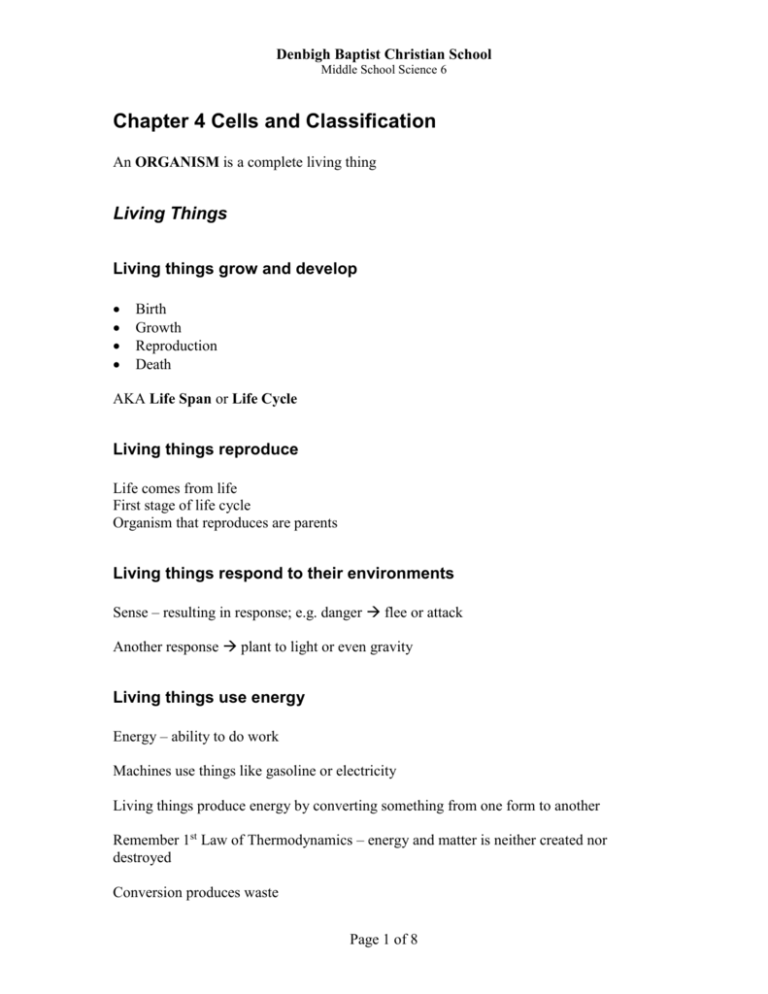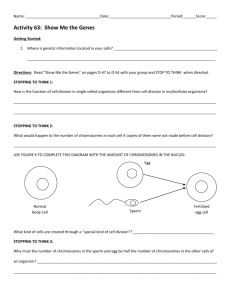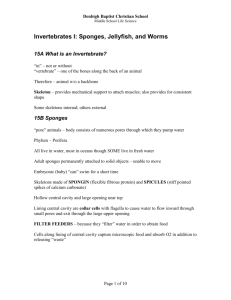Plant Kingdom: Structure - Denbigh Baptist Christian School
advertisement

Denbigh Baptist Christian School Middle School Science 6 Chapter 4 Cells and Classification An ORGANISM is a complete living thing Living Things Living things grow and develop Birth Growth Reproduction Death AKA Life Span or Life Cycle Living things reproduce Life comes from life First stage of life cycle Organism that reproduces are parents Living things respond to their environments Sense – resulting in response; e.g. danger flee or attack Another response plant to light or even gravity Living things use energy Energy – ability to do work Machines use things like gasoline or electricity Living things produce energy by converting something from one form to another Remember 1st Law of Thermodynamics – energy and matter is neither created nor destroyed Conversion produces waste Page 1 of 8 Denbigh Baptist Christian School Middle School Science 6 e.g. cells use O2 to produce energy but produce CO2 as waste product (respiration) Living things are made of cells Robert Hooke observed cork under microscope and observed “cells” CELL – smallest unit of living organism Schwann and Schleiden observed that all living things are made of cells while nonliving things are NOT made of cells Schwann and Schleiden conclusions are known as cell theory Cells are observable under a microscope Cells Cells working together Cell – tiny unit of living material surrounded by thin membrane Grows Reproduces Responds to environment Use energy Produces and gets rid of waste Dies Unicellular – many organisms exist as single cells Multicellular – living organisms where millions of cells exist together Cells become specialized … like members of a baseball team; everybody can run/throw/catch but some are pitchers others are hitters Tissue – group of cells working together; e.g. heart tissue Organs – tissues working together for a specific purpose; e.g. heart, lungs Systems – organs working together; e.g. circulatory system or nervous system Page 2 of 8 Denbigh Baptist Christian School Middle School Science 6 Cell structures Cells exist in a wide range of sizes and shapes; e.g. red blood cell flat disc muscles – long thin Cell membrane – surrounds all cells and is an external boundary; keeps stuff in and stuff out Cytoplasm – jelly like substance inside membrane; provides most of cell volume Organelles – tiny structure in cell which carries out specialized functions of the cell e.g. chloroplast or nucleus In some respects it appears like an organelle is a cell inside the cell Nucleus – contains DNA which is packed into tiny bundles called chromosomes DNA – determines what organism looks like Mitochondria – organelle like an engine; breaks down “food” to produce energy Endoplasmic reticulum – AKA ER is a transportation system like highway Ribosomes – organelle that makes proteins needed by cell; also carry out instructions of DNA Vacuoles – organelle that temporarily stores material until released (waste) or used by cell Cell wall – additional item in PLANT cells that provides structural support Chloroplast – organelle containing chlorophyll that is responsible for photosynthesis Photosynthesis – CO2 + H2O + sunlight + chlorophyll sugar + O2 Animal cells never utilize photosynthesis Page 3 of 8 Denbigh Baptist Christian School Middle School Science 6 Reproduction of Cells Reproduction of cells is a requirement – otherwise organism dies and becomes extinct Cell division – two different ways Mitosis Meiosis Mitosis – cell makes an exact copy of itself (remember “to”) One cell first makes exact copy of chromosomes Chromosomes separate and move to opposite ends of cell Cell divides into two parts with full set of chromosomes Bottom line: 1 cell has now produced 2 cells where each is EXACTLY same as original (same number of chromosomes) Reproduction of Multicellular Organisms When a puppy grows and gets larger, the cells undergo mitosis to make more of the cells To get a new puppy, there must be meiosis This process is known as SEXUAL REPRODUCTION One cell first makes exact copy of chromosomes Chromosomes separate and move to opposite ends of cell Cell divides into two parts with full set of chromosomes (Recognize this begins same way that MITOSIS did) Now each of these two cells starts the process over, but does NOT make copy of chromosomes When cell division occurs, each new cell only has ½ of the chromosomes Bottom line; 1 cell has now produced 4 cells where each has only ½ of chromosomes These new cells are considered to be MALE and FEMALE. It’s not until a MALE and FEMALE cell join that the resultant cell has the complete number of chromosomes again Page 4 of 8 Denbigh Baptist Christian School Middle School Science 6 Classification Classification – organizing of organisms with similar characteristics Carolus Linnaeus – Swedish scientist responsible for current classification system Currently six kingdoms 1) 2) 3) 4) 5) 6) Eubacteria Archaebacteria Protista Fungi Plantae Animalia The Living Kingdoms Kingdom Eubacteria Microscopic organism Unicellular Groups of them are known as colonies Bacteria do not have well defined nuclei Exist EVERYWHERE Useful in intestines to help digest food Yogurt Like warm moist environment Kingdom Archaebacteria Microscopic organism Unicellular Can exist in hostile environment Page 5 of 8 Denbigh Baptist Christian School Middle School Science 6 Kingdom Protista Microscopic organism Unicellular Cell membranes Nuclei Two kinds Protozoan Algae Protozoan – two kinds 1) paramecium 2) amoeba Paramecium – propels via hair-like structures called cilia Amoeba – propels by changing body shape; eats by surrounding food Algae – not mobile like protozoans Have chlorophyll – produce food from sunlight Kingdom Fungi Unicellular and colonial Generally no cell walls No chlorophyll cannot produce own food Most common – mushroom which lives off of decaying plant/animal matter Bread mold another example Yeast – causes bread to rise is also a fungus (Bible called leaven) Athlete’s food – fungus Page 6 of 8 Denbigh Baptist Christian School Middle School Science 6 Kingdom Plantae Very important kingdom – provides food and O2 for all living things Chloroplast – organelle in plant cell that is responsible for photosynthesis Cell walls – provide structural support Important tissue – bark, leaves and roots Kingdom Animalae Very large and diverse Multi-cellular No cell walls Many have skeletal system for support DO NOT manufacture food; must “hunt/gather” Nervous system allows to respond to environment; to include “smell” food Consider jellyfish and flatworms – few organs Humans – technically have many same traits; however we know that God created man in His own image and gave him dominion over earth; Genesis 1:27 Page 7 of 8 Denbigh Baptist Christian School Middle School Science 6 Naming Organisms Common names are ineffective when you consider size and number of living organisms Linnaeus developed classification system Kingdom Phylum Class Order Family Genus Species Common characteristics Scientific names – genus and species Must be underlined First letter of genus capitalized Species NOT capitalized When typed, italics w/o underline is also acceptable e.g. Canis familiaris or Canis familiaris When considering classification, it makes us more appreciate all of God’s creation and overall plan Page 8 of 8







